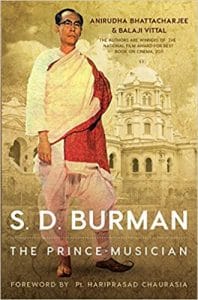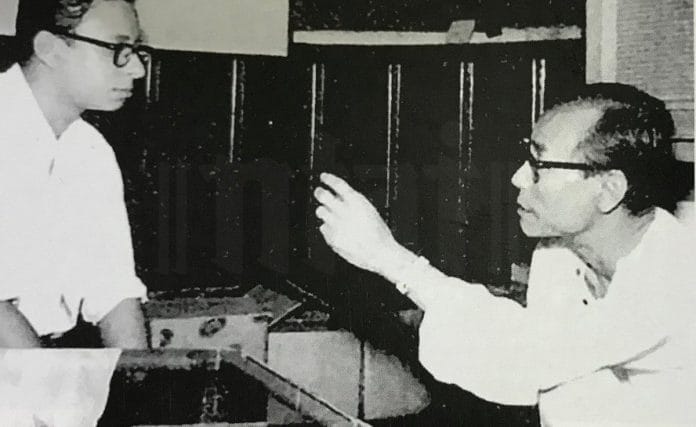The legendary musician never shied away from experimenting with new shades of rhythms and was eternally resilient to constantly improve his compositions.
“…SD was Anuraag’s lead ‘playback singer’. Sun ri pavan and Neend churaye chain churaye were the Hindi versions of two of his most popular Bengali solos,Ke jaash re and Baanshi shune aar kaaj nai. Lata was once again entrusted with the task of creating classics from the original Bengali.
There was a third, although not a very popular Lata song—Mera raja beta bole, the last lullaby composed by SD. Like Nanhi kali sone chali (Sujata), the lines had a drawn-out effect.
Anuraag also happened to be Shakti Samanta’s last film with SD, as RD had stepped in to take over the mantle. One can only speculate whether Samanta would have considered SD for films like Mehbooba (1976) or Anurodh (1977), had the maestro been alive and willing to work.
The Action-packed 1970s
The Seventies belonged to action drama, a genre which flourished like no other in the history of Hindi cinema. According to some accounts, the sudden spurt was in protest to Nehruvian socialism—India had been ravaged by three wars (one with China, and two with Pakistan); the poor were burdened by escalating prices; but the politicians, as always, cocked a snook at the masses and added to their coffers by indulging in unprecedented corruption. The poor-rich divide had widened to such an extent that mini revolutions were witnessed in different parts of the country. It was this churn brought about by hunger, anger and despondency which created space for the rise of the ‘Angry young man’ and he arrived, much like the messiah of the poor. His name was Amitabh Bachchan.
Considering there was a paradigm shift in Indian society, the film industry was naturally impacted by it. While several artists struggled to keep up with the times, many found ways to align themselves with the imminent change. The change percolated to the music industry as well. Ironically, while music was never the focal point in action-packed films, music directors had to work doubly hard to keep themselves afloat.
In September 1966, in an article in Cine Advance, SD argued that a song was important to a film only if it was cinematically well presented.
This one statement proved how well he understood the medium and even as action films were slowly taking over the industry, SD was singularly focussed on bettering his compositions. There is no gainsaying the fact that his music for every action-based film during the period was not only unforgettable, but also a perfect fit for the times. Despite his advancing age, the man was most willing to experiment, like using voices from outside the music fraternity. The well known actor and an alumni of the FTII, Danny Denzongpa in a chat with the authors, said, ‘I was the original choice for the role of a tribal (Dev Anand’s sidekick) in Yeh Gulistan Hamara, which was released in 1972. S.D. Burman had heard me singing a tune that he liked, and composed Mera naam aao based on that. He wanted me to sing the song too. In effect, I was to do my own playback.
‘Johnny Walker, who was a constant fixture in every Guru Dutt production, came and asked the director of the film, Atma Ram (who was Guru Dutt’s younger brother), “No role for Johnny Walker in a Guru Dutt film?” Atma Ram convinced me to give up the role, which I did.
‘But S.D. Burman wanted me to sing Mera Naam Aao. Now, Atma Ram wanted some other singer, since I was neither part of the cast, nor a professional singer. Burman Dada was furious and said that he would not compose the music, as Atma Ram had no business taking decisions about the music. Atma Ram apologised profusely to Burman Dada and he finally relented.
‘On the first day of the music sitting, I landed up at Burman Dada’s place wading through knee-deep rain water. Dada chided me never to do that as it could adversely affect my voice. He told me to dry my legs, and have a cup of tea first.
‘During the rehearsal, I wanted multiple mics around me, as my body would sway with the rhythm while singing. So, Burman Dada kept six mics and I kept swinging and singing.’
Although Yeh Gulistan Hamara, starring Dev Anand and Sharmila Tagore (the only time they worked together), failed to do good business, Gori gori gaon ki gori re (Kishore–Lata), Suno meri baat (Kishore and chorus), and Mera naam aao (Danny–Lata) were chartbusters.
Alas, the film’s failure proved to be the end of SD’s twenty-year-old relationship with Guru Dutt Productions that had started with Baazi. Atma Ram offered him Aarop (1974), but SD passed it to his admirer-turned-friend, the late Dr Bhupen Hazarika.
The song Raina soyi soyi, sung by Lata and chorus in Yeh Gulistan Hamara was the only instance when both father and son—SD and RD—sang together …”
 This is an excerpt from the book, S. D. Burman: The Prince-Musician by Anirudha Bhattacharjee and Balaji Vittal. The book is published by Westland Publications.
This is an excerpt from the book, S. D. Burman: The Prince-Musician by Anirudha Bhattacharjee and Balaji Vittal. The book is published by Westland Publications.






